Ranking of Sustainability Indicators for Assessment of the New Housing Development Projects: Case of the Baltic States
Abstract
:1. Introduction
2. Literature Review
3. Materials and Methods
4. Results and Discussion
4.1. Environmental Sustainability Dimension
4.1.1. Land Use Considerations
4.1.2. Water Efficiency Considerations
4.1.3. Energy and Atmosphere Considerations
4.1.4. Materials and Waste Management
4.1.5. Indoor Environmental Quality
4.1.6. External Pollution
4.1.7. Innovation and Design Process Considerations
4.2. Social Sustainability Dimension
4.2.1. Accessibilities
4.2.2. Neighbourhood/Community Considerations
4.3. Economic Sustainability Dimension
4.4. Ranking of Sustainability Dimensions
4.5. Recommendations
- Research revealed that sustainable new housing development projects should encompass three main sustainability dimensions: environmental, economic and social. This triangular sustainability should be incorporated in local strategies and assessed according to substantial indicators. Developing such assessment framework should be based on scientific research and practical knowledge. Experts, designers, developers and other stakeholders should be introduced as key participants in this process. As proposed by Scolobig and Lilliestam [74], “stakeholders’ perspectives can be included in the shape of qualitative, quantitative, or mixed data, and often a translation of qualitative views into alternatives, technical options, models, or scenarios—including quantification efforts adds difficulty and complexity to the process, but can also enrich the final outcome”.
- Energy and atmosphere considerations, materials and waste management are among the top priorities of the new residential projects in the Baltic States. Therefore, developers are encouraged to build new energy efficient residential buildings from environmental friendly, reused and recycled materials. Moreover, from the economic point of view, these projects should be affordable and from the social perspective—infrastructure efficient in respect to public transportation and access to the most important public amenities (schools, kinder gardens, healthcare institutions, etc.).
- To promote sustainable new residential projects, the national contests could be organised in Latvia and Estonia. Good practice example in this case is initiative of the Lithuanian Real Estate Developers Association.
- As the findings of research were in line with the findings of the other authors, it is suggested that Baltic States can learn sustainability principles from the other countries’ work, ideas, frameworks, and best practices; however, new sustainable residential projects should suit the local context, depending on the culture, legislation, policy, stakeholders, practices and institutions.
5. Conclusions
Supplementary Materials
Acknowledgments
Author Contributions
Conflicts of Interest
References
- World Commission on Environment and Development. Our Common Future; Oxford University Press: New York, NY, USA, 1987; Available online: http://www.un-documents.net/our-common-future.pdf (accessed on 7 May 2017).
- Heravi, G.; Fathi, M.; Faeghi, S. Evaluation of sustainability indicators of industrial buildings focused on petrochemical projects. J. Clean. Prod. 2015, 109, 92–107. [Google Scholar] [CrossRef]
- Holmstedt, L.; Brandt, N.; Robèrt, K.-H. Can Stockholm Royal Seaport be part of the puzzle towards global sustainability?—From local to global sustainability using the same set of criteria. J. Clean. Prod. 2017, 140, 72–80. [Google Scholar] [CrossRef]
- Zhang, X.; Shen, L.; Wu, Y. Green strategy for gaining competitive advantage in housing development: A China study. J. Clean. Prod. 2011, 19, 157–167. [Google Scholar] [CrossRef]
- Hwang, B.G.; Tan, J.S. Green building project management: obstacles and solutions for sustainable development. Sustain. Dev. 2012, 20, 335–349. [Google Scholar] [CrossRef]
- Arman, M.; Zuo, J.; Wilson, L.; Zillante, G.; Pullen, S. Challenges of responding to sustainability with implications for affordable housing. Ecol. Econ. 2009, 68, 3034–3041. [Google Scholar] [CrossRef]
- Maliene, V.; Malys, N. High-quality housing—a key issue in delivering sustainable communities. Build. Environ. 2009, 44, 426–430. [Google Scholar] [CrossRef]
- European Commission (EC). Energy Roadmap 2050; European Commission: Brussels, Belgium, 2011; Available online: https://ec.europa.eu/energy/sites/ener/files/documents/2012_energy_roadmap_2050_en_0.pdf (accessed on 10 May 2017).
- Mateus, R.; Braganca, L. Sustainability assessment and rating of buildings: Developing the methodology SBToolPT—H. Build. Environ. 2011, 46, 1962–1971. [Google Scholar] [CrossRef]
- Egilmez, G.; Gumus, S.; Kucukvar, M. Environmental sustainability benchmarking of the U.S. and Canada metropoles: An expert judgment-based multi-criteria decision making approach. Cities 2015, 42, 31–41. [Google Scholar] [CrossRef]
- Capolongo, S.; Buffoli, M.; Oppio, A.; Petronio, M. Sustainability and hygiene of building: Future perspectives. Epidemiol. Prev. 2014, 38, 46–50. [Google Scholar] [PubMed]
- Zhang, X.; Wu, Y.; Shen, L.; Skitmore, M. A prototype system dynamic model for assessing the sustainability of construction projects. Int. J. Proj. Manag. 2014, 32, 66–76. [Google Scholar] [CrossRef] [Green Version]
- Viteikiene, M.; Zavadskas, E.K. Evaluating the sustainability of Vilnius city residential areas. J. Civ. Eng. Manag. 2007, 13, 149–155. [Google Scholar]
- Zavadskas, E.K.; Cavallaro, F.; Podvezko, V.; Ubarte, I.; Kaklauskas, A. MCDM assessment of a healthy and safe built environment according to sustainable development principles: A practical neighborhood approach in Vilnius. Sustainability 2017, 9, 702. [Google Scholar] [CrossRef]
- Brizga, J. How well sustainable development is integrated into environmental policies? Case study: Latvia, Saf. Technol. Environ. 2012, 2, 24–34. [Google Scholar]
- Zilans, A.; Abolina, K. A methodology for assessing urban sustainability: Aalborg commitments baseline review for Riga, Latvia. Environ. Dev. Sustain. 2009, 11, 85–114. [Google Scholar] [CrossRef]
- Geipele, I.; Kauškale, L.; Lepkova, N.; Liias, R. Interaction of socio-economic factors and real estate market in the context of sustainable urban development. In Proceedings of the 9th International Conference “Environmental Engineering”, Vilnius, Lithuania, 22–23 May 2014; pp. 1–8. [Google Scholar]
- Nuuter, T.; Lill, I.; Tupenaite, L. Comparison of housing market sustainability in European countries based on multiple criteria assessment. Land Use Policy 2015, 42, 642–651. [Google Scholar] [CrossRef]
- Lithuanian Real Estate Developers Association (LNTPA). Available online: http://lntpa.lt/darnios-pletros-akademija/konkursai-uz-darnia-pletra-ir-darni-aplinka/ (accessed on 10 July 2017).
- Latvian Sustainable Building Council (LSBC). Available online: http://www.ibp.lv/en (accessed on 10 July 2017).
- Estonian Green Building Council (Eesti GBC). Available online: http://www.gbc.ee/gbc_eng.html (accessed on 10 July 2017).
- Agol, D.; Latawiec, A.E.; Strassburg, B.B.N. Evaluating impacts of development and conservation projects using sustainability indicators: Opportunities and challenges. Environ. Impact Assess. Rev. 2014, 48, 1–9. [Google Scholar] [CrossRef]
- Wallbaum, H.; Ostermeyer, Y.; Salzer, C.; Zea Escamilla, E. Indicator based sustainability assessment tool for affordable housing construction technologies. Ecol. Indic. 2012, 18, 353–364. [Google Scholar] [CrossRef]
- Abdul-Rahman, H.; Wang, C.; Ebrahimi, M. Integrating and ranking sustainability criteria for housing. Proc. Inst. Civ. Eng. Eng. Sustain. 2016, 169, 3–30. [Google Scholar] [CrossRef] [Green Version]
- Berardi, U. Clarifying the new interpretations of the concept of sustainable building. Sustain. Cities Soc. 2013, 8, 72–78. [Google Scholar] [CrossRef]
- Ali, H.H.; Al Nsairat, S.F. Developing a green building assessment tool for developing countries e case of Jordan. J. Build. Environ. 2009, 44, 1053–1064. [Google Scholar] [CrossRef]
- Alwaer, H.; Clements-Croome, D.J. Key performance indicators (KPIs) and priority setting in using the multi-attribute approach for assessing sustainable intelligent buildings. J. Build. Environ. 2010, 45, 799–807. [Google Scholar] [CrossRef]
- Bragança, L.; Mateus, R.; Koukkari, H. Building sustainability assessment. Sustainability 2010, 2, 2010–2023. [Google Scholar] [CrossRef]
- Bakar, A.H.A.; Cheen, K.S. Sustainable housing practices in Malaysian housing development: Towards establishing sustainability index. IJTech 2011, 1, 84–93. [Google Scholar]
- Turcu, C. Re-thinking sustainability indicators: Local perspectives of urban sustainability. J. Environ. Plan. Manag. 2013, 56, 695–719. [Google Scholar] [CrossRef]
- Mulliner, E.; Smallbone, K.; Maliene, V. An assessment of sustainable housing affordability using a multiple criteria decision making method. Omega 2013, 41, 270–279. [Google Scholar] [CrossRef]
- Chandratilake, S.R.; Dias, W.P.S. Sustainability rating systems for buildings: comparisons and correlations. Energy 2013, 59, 22–28. [Google Scholar] [CrossRef]
- Alyami, S.H.; Rezgui, Y.; Kwan, A. Developing sustainable building assessment scheme for Saudi Arabia: Delphi consultation approach. Renew. Sustain. Energy Rev. 2013, 27, 43–54. [Google Scholar] [CrossRef]
- Mardani, A.; Zavadskas, E.K.; Streimikiene, D.; Jusoh, A.; Nor, K.M.D.; Khoshnoudi, M. Using fuzzy multiple criteria decision making approaches for evaluating energy saving technologies and solutions in five star hotels: A new hierarchical framework. Energy 2016, 117, 131–148. [Google Scholar] [CrossRef]
- Higham, A.; Stephenson, P. Identifying project success criteria for UK social housing asset management schemes. In Proceedings of the 30th Annual ARCOM Conference, Association of Researchers in Construction Management, Portsmouth, UK, 1–3 September 2014; pp. 33–42. [Google Scholar]
- Yu, W.; Li, B.; Yang, X.; Wang, Q. A development of a rating method and weighting system for green store buildings in China. Renew. Energy 2015, 73, 123–129. [Google Scholar] [CrossRef]
- Nilashi, M.; Zakaria, R.; Ibrahim, O.; Majid, M.Z.A.; Zin, R.M.; Chugtai, M.W.; Abidin, N.I.Z.; Sahamir, S.R.; Yakubu, D.A. A knowledge-based expert system for assessing the performance level of green buildings. Knowl.-Based Syst. 2015, 86, 194–209. [Google Scholar] [CrossRef]
- Preval, N.; Randal, E.; Chapman, R.; Moores, J.; Howden-Chapman, P. Streamlining urban housing development: Are there environmental sustainability impacts? Cities 2016, 55, 101–112. [Google Scholar] [CrossRef]
- Burdova, E.K.; Vilcekova, S. Sustainable building assessment tool in Slovakia. Energy Procedia 2015, 78, 1829–1834. [Google Scholar] [CrossRef]
- Kang, H.; Lee, Y.; Kim, S. Sustainable building assessment tool for project decision makers and its development process. Environ. Impact Assess. Rev. 2016, 58, 34–47. [Google Scholar] [CrossRef]
- Higham, A.P.; Fortune, C.; Boothman, J.C. Sustainability and investment appraisal for housing regeneration projects. Struct. Surv. 2016, 34, 150–167. [Google Scholar] [CrossRef] [Green Version]
- Saaty, T.L. The Analytic Hierarchy Process: Planning, Priority Setting, Resource Allocation; McGraw-Hill: New York, NY, USA, 1980. [Google Scholar]
- Gan, X.; Fernandez, I.C.; Guo, J.; Wilson, M.; Zhao, Y.; Zhou, B.; Wu, J. When to use what: Methods for weighting and aggregating sustainability indicators. Ecol. Indic. 2017, 81, 491–502. [Google Scholar] [CrossRef]
- Si, J.; Marjanovic-Halburd, L.; Nasiri, F.; Bell, S. Assessment of building-integrated green technologies: A review and case study on applications of Multi-Criteria Decision Making (MCDM) method. Sustain. Cities Soc. 2016, 27, 106–115. [Google Scholar] [CrossRef]
- Işik, Z.; Aladağ, H. A fuzzy AHP model to assess sustainable performance of the construction industry from urban regeneration perspective. J. Civ. Eng. Manag. 2017, 23, 499–509. [Google Scholar] [CrossRef]
- Yan, M.-R.; Pong, C.-S.; Lo, W. Utility-based multicriteria model for evaluating BOT projects. Technol. Econ. Dev. Eco. 2011, 17, 207–218. [Google Scholar] [CrossRef]
- Turskis, Z.; Morkunaite, Z.; Kutut, V. A hybrid multiple criteria evaluation method of ranking of cultural heritage structures for renovation projects. Int. J. Strateg. PROP M 2017, 21, 318–329. [Google Scholar] [CrossRef]
- Kaya, İ.; Kahraman, C. A comparison of fuzzy multicriteria decision making methods for intelligent building assessment. J. Civ. Eng. Manag. 2014, 20, 59–69. [Google Scholar] [CrossRef]
- Gudienė, N.; Banaitis, A.; Podvezko, V.; Banaitienė, N. Identification and evaluation of the critical success factors for construction projects in Lithuania: AHP approach. J. Civ. Eng. Manag. 2014, 20, 350–359. [Google Scholar] [CrossRef]
- Fouladgar, M.M.; Yazdani-Chamzini, A.; Lashgari, A.; Zavadskas, E.K.; Turskis, Z. Maintenance strategy selection using AHP and COPRAS under fuzzy environment. Int. J. Strateg. PROP M 2012, 16, 85–104. [Google Scholar] [CrossRef]
- Khalil, N.; Kamaruzzaman, S.N.; Baharum, M.R. Ranking the indicators of building performance and the users’ risk via Analytical Hierarchy Process (AHP): Case of Malaysia. Ecol. Indic. 2016, 71, 567–576. [Google Scholar] [CrossRef]
- Sindhu, S.; Nehra, V.; Luthra, S. Solar energy deployment for sustainable future of India: Hybrid SWOC-AHP analysis. Renew. Sustain. Energy Rev. 2017, 72, 1138–1151. [Google Scholar] [CrossRef]
- Banani, R.; Vahdati, M.M.; Shahrestani, M.; Clements-Croome, D. The development of building assessment criteria framework for sustainable non-residential buildings in Saudi Arabia. Sustain. Cities Soc. 2016, 26, 289–305. [Google Scholar] [CrossRef]
- Rodriguez-Trejo, S.; Ahmad, A.M.; Hafeez, M.A.; Dawood, H.; Vukovic, V.; Kassem, M.; Naji, K.K.; Dawood, N. Hierarchy based information requirements for sustainable operations of buildings in Qatar. Sustain. Cities Soc. 2017, 32, 435–448. [Google Scholar] [CrossRef]
- Moussaoui, F.; Cherrared, M.; Kacimi, M.A.; Belarbi, R. Genetic Algorithm to optimize consistency ratio in AHP method for energy performance assessment of residential buildingsAlgerian case study. Sustain. Cities Soc. 2017. [Google Scholar] [CrossRef]
- Capolongo, S.; Bottero, M.C.; Buffoli, M.; Lettieri, E. (Eds.) Improving Sustainability during Hospital Design and Operation: A Multidisciplinary Evaluation Tool; Springer: Cham, Switzerland, 2015. [Google Scholar] [CrossRef]
- Cegan, J.C.; Filion, A.M.; Keisler, J.M.; Linkov, I. Trends and applications of multi-criteria decision analysis in environmental sciences: Literature review. Environ. Syst. Decis. 2017, 37, 123–133. [Google Scholar] [CrossRef]
- Mardani, A.; Jusoh, A.; Zavadskas, E.K.; Cavallaro, F.; Khalifah, Z. Sustainable and renewable energy: An overview of the application of multiple criteria decision making techniques and approaches. Sustainability 2015, 7, 13947–13984. [Google Scholar] [CrossRef]
- Kendall, M.G. Rank Correlation Methods, 4th ed.; Griffin: London, UK, 1970. [Google Scholar]
- BREEAM. Available online: http://www.breeam.com/ (accessed on 15 May 2017).
- GBTool. Available online: http://iisbe.org/gbc2k/gbtool/gbtool-main.htm (accessed on 15 May 2017).
- LEED. Available online: https://www.usgbc.org/leed (accessed on 15 May 2017).
- Shen, L.Y.; Tam, V.W.Y.; Tam, L.; Ji, Y. Project feasibility study: The key to successful implementation of sustainable and socially responsible construction management practice. J. Clean. Prod. 2010, 18, 254–259. [Google Scholar] [CrossRef]
- CASBEE. Available online: http://www.ibec.or.jp/CASBEE/english/ (accessed on 15 May 2017).
- Mulliner, E.; Malys, N.; Maliene, V. Comparative analysis of MCDM methods for the assessment of sustainable housing affordability. Omega 2016, 59, 146–156. [Google Scholar] [CrossRef]
- Newell, P.J.; Seymour, M.; Yee, T.; Renteria, J.; Longcore, T.; Wolch, R.J.; Shishkovsky, A. Green Alley Programs: Planning for a sustainable urban infrastructure? Cities 2013, 31, 144–155. [Google Scholar] [CrossRef]
- Ceron-Palma, I.; Sanyé-Mengual, E.; Oliver-Solà, J.; Montero, J.; Ponce-Caballero, C.; Rieradevall, J. Towards a green sustainable strategy for social neighbourhoods in Latin America: Case from social housing in Merida, Yucatan, Mexico. Habitat Int. 2013, 38, 47–56. [Google Scholar] [CrossRef]
- Pearce, A.R.; Hastak, M.; Vanegas, J.A. A Decision support system for construction materials selection using sustainability as a criterion. In Proceedings of the 2012 Symposium on Simulation for Architecture and Urban Design (SimAUD ’12), Society for Computer Simulation International, San Diego, CA, USA, 28–31 October 2012; pp. 1–5. [Google Scholar]
- Lai, A.C.K.; Mui, K.W.; Wong, L.T.; Law, L.Y. An evaluation model for indoor environmental quality (IEQ) acceptance in residential buildings. Energy Build. 2009, 41, 930–936. [Google Scholar] [CrossRef]
- Holden, M.; Scerri, A. More than this: Liveable Melbourne meets liveable Vancouver. Cities 2013, 31, 444–453. [Google Scholar] [CrossRef]
- Zavrl, M.S.; Zarnic, R.; Selih, J. Multicriterial sustainability assessment of residential buildings. Technol. Econ. Dev. Eco. 2009, 15, 612–630. [Google Scholar] [CrossRef]
- BPMSG AHP Online System. Available online: http://bpmsg.com/academic/ahp_calc.php (accessed on 5 May 2017).
- Ceccato, V.; Lukyte, N. Safety and sustainability in a city in transition: The case of Vilnius, Lithuania. Cities 2011, 28, 83–94. [Google Scholar] [CrossRef]
- Scolobig, A.; Lilliestam, J. Comparing approaches for the integration of stakeholder perspectives in environmental decision making. Resources 2016, 5, 37. [Google Scholar] [CrossRef]
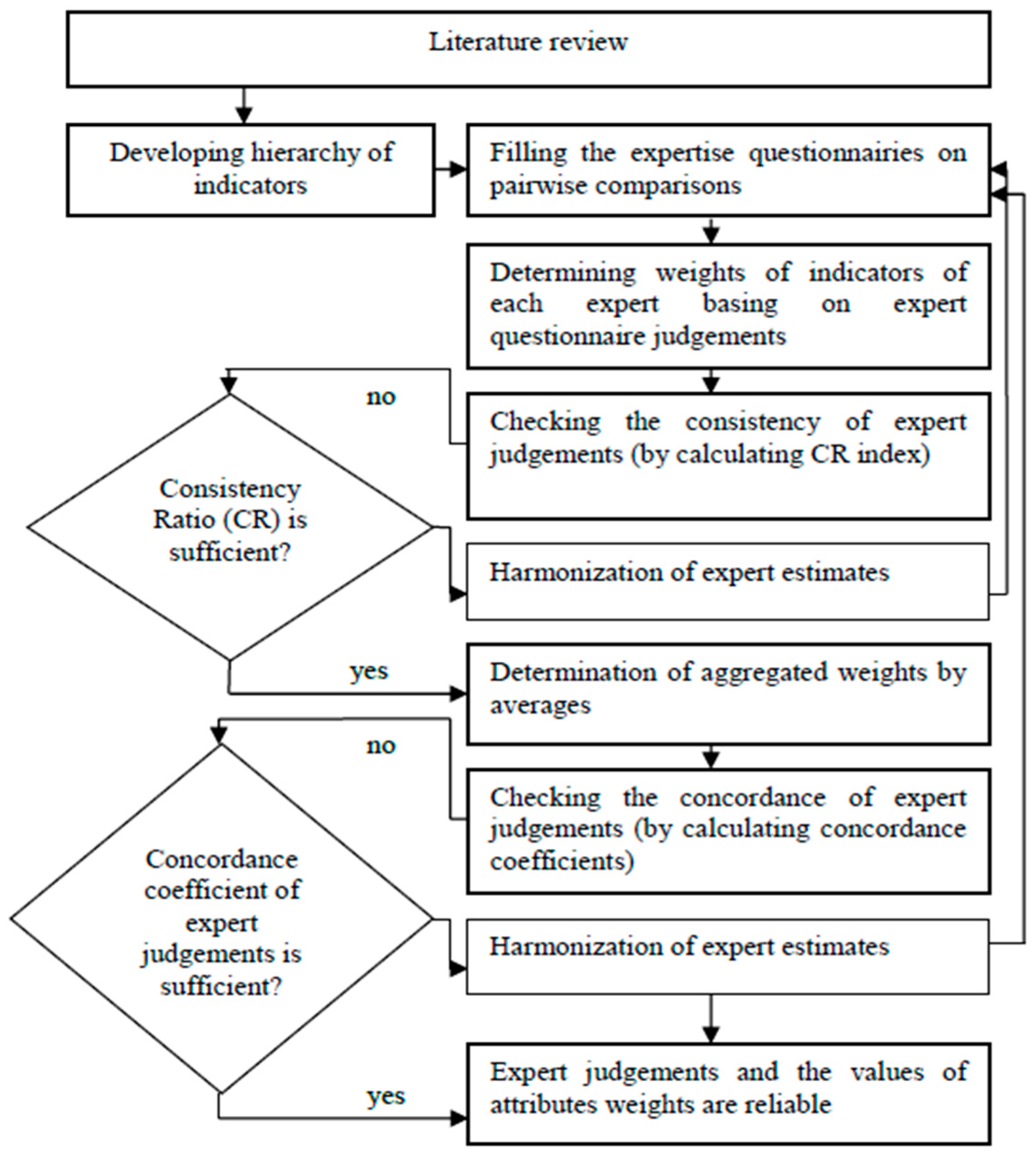
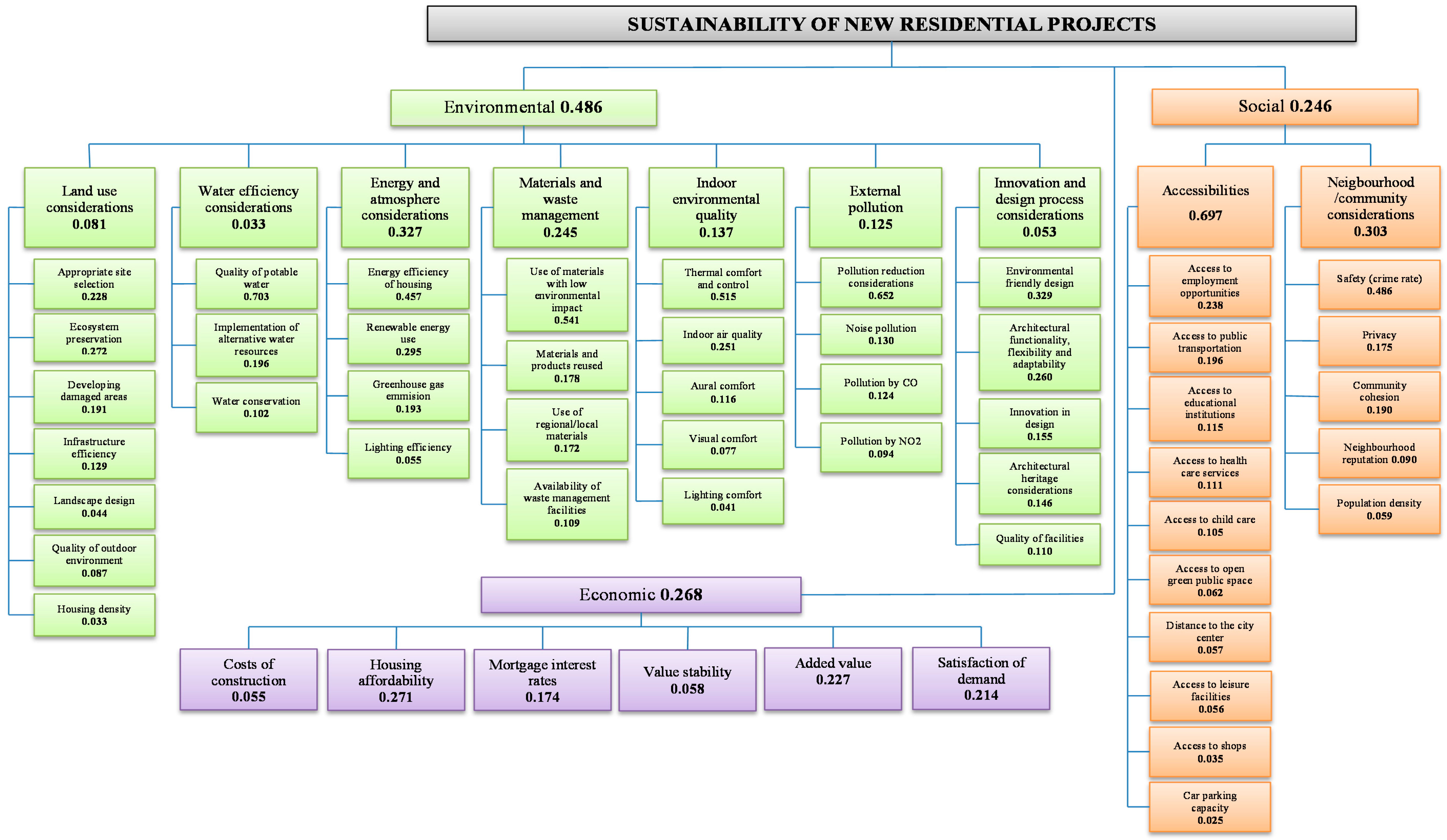
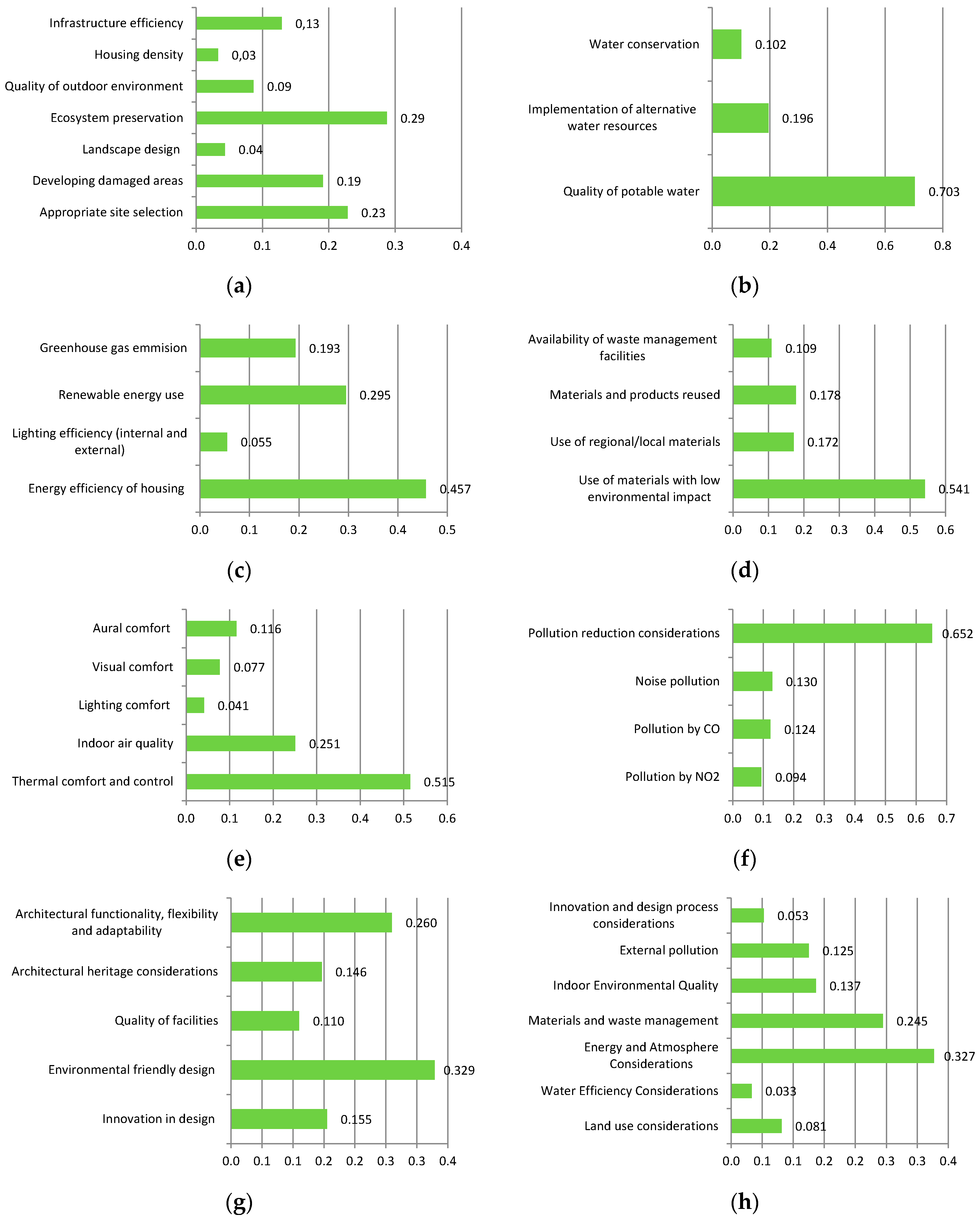
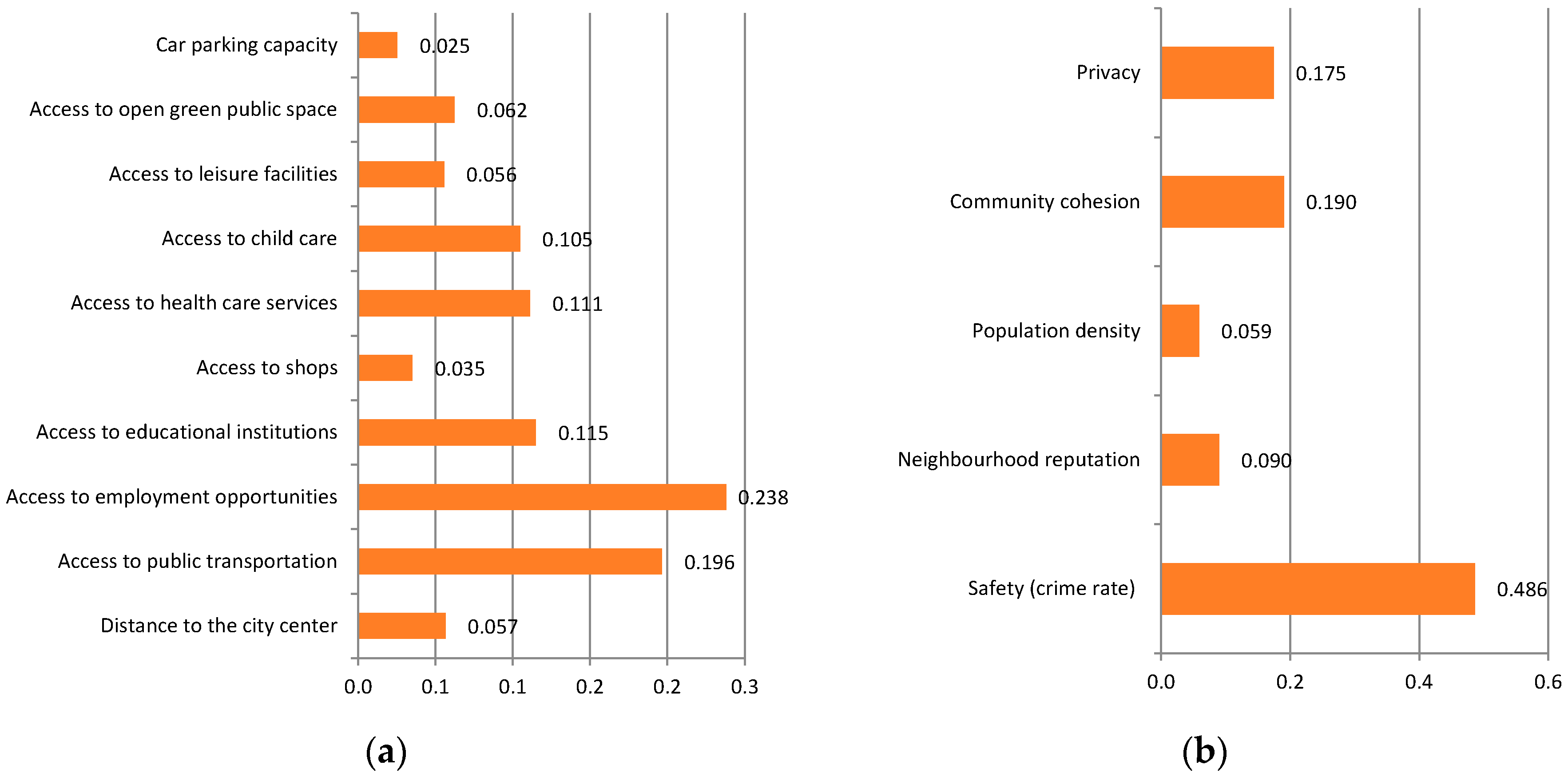

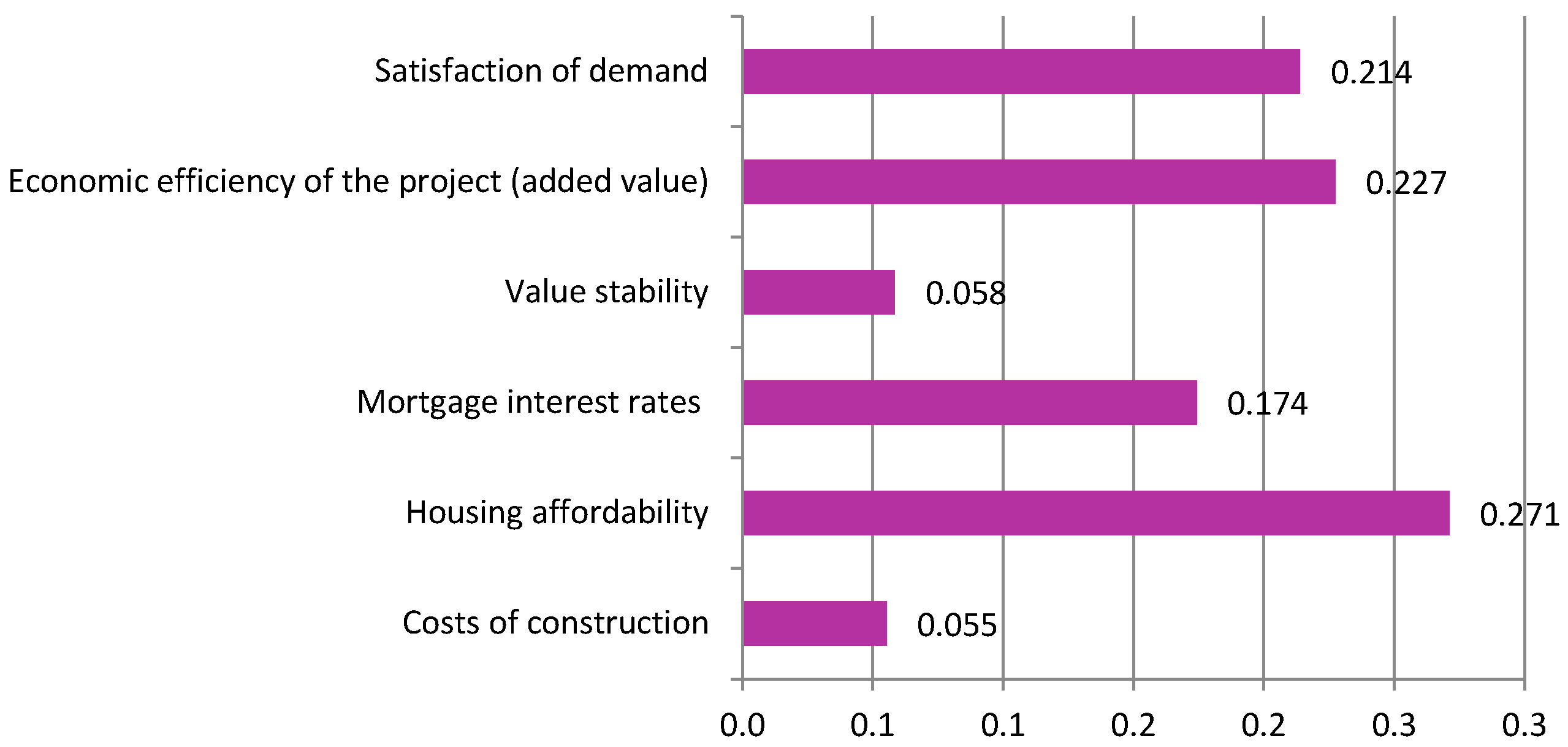
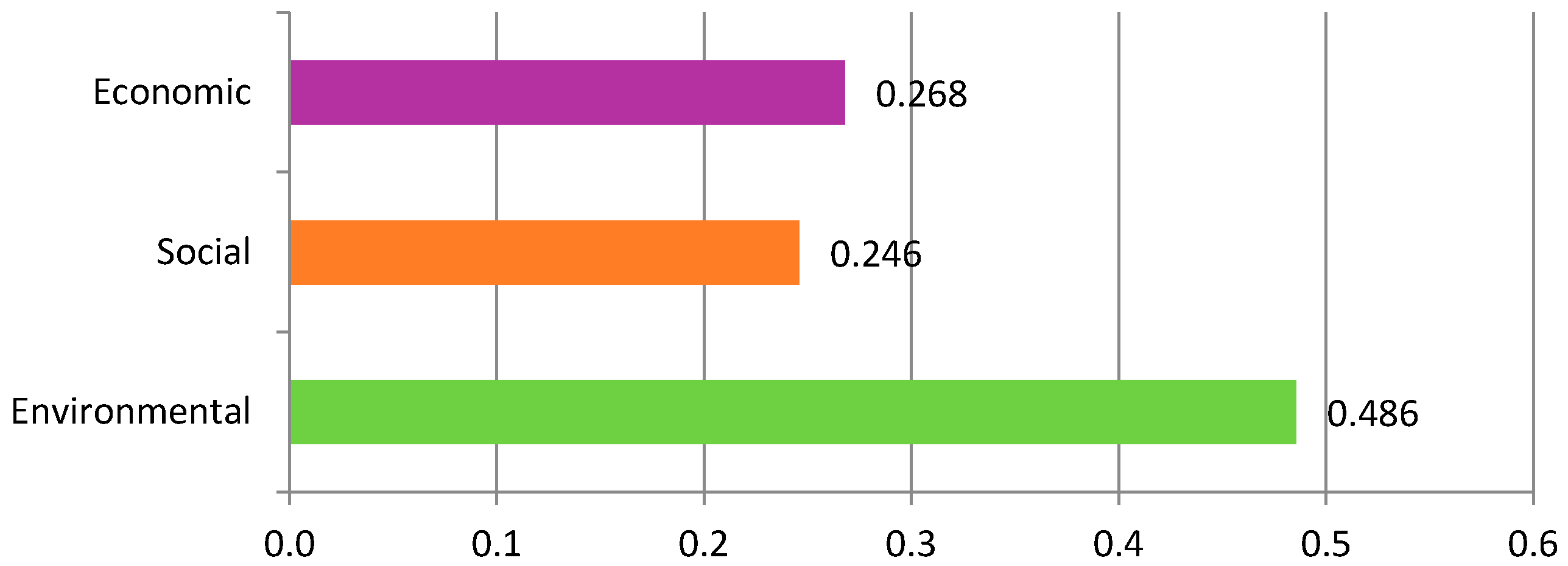
| Intensity of Importance | Definition | Explanation |
|---|---|---|
| 1 | Equal importance | Two indicators contribute equally to the objective |
| 3 | Moderate importance | Experience and judgment slightly favour one to another |
| 5 | Strong importance | Experience and judgment strongly favour one to another |
| 7 | Very strong importance | An indicator is strongly favoured and its dominance is demonstrated in practice |
| 9 | Absolute importance | The importance of one over another affirmed on the highest possible order |
| 2,4,6,8 | Intermediate values | Used to represent compromise between the priorities listed above |
| Reciprocals of above non-zero numbers | If indicator i has one of the above non-zero numbers assigned to it when compared with indicator j , then j has the reciprocal value when compared with i | |
| No. | Country | Specialty | Work Experiences (Years) | Expertise in Sustainability Issues |
|---|---|---|---|---|
| E1 | Lithuania | Civil engineer | 10 | Consultant in buildings’ certification according to the BREEAM system |
| E2 | Lithuania | Academic (Dr., Assoc. Prof.) | 11 | Teaches subject “Sustainable development of territories”, took internship in the Lithuanian Real Estate Developers Association |
| E3 | Lithuania | Analyst | 15 | Works in State Enterprise Centre of Registers, prepares market reviews that consider sustainability issues |
| E4 | Latvia | Surveyor | 20 | Consults clients on sustainability issues |
| E5 | Latvia | Academic (Dr., Assoc. Prof.) | 18 | Teaches subject “Sustainable urban development”, participates in international projects |
| E6 | Latvia | Architect | 10 | Designs passive houses |
| E7 | Estonia | Real estate developer | 12 | Develops innovative residential projects |
| E8 | Estonia | Valuator | 10 | Valuates real estate |
| E9 | Estonia | Academic (Dr., Assoc. Prof.) | 32 | Researches housing sustainability issues, participates in international projects |
| Dimension | Category | Indicators | References |
|---|---|---|---|
| Environmental sustainability | Land use considerations | Appropriate site selection | [3,9,19,24,26,27,28,32,33,36,37,39,40,60,61,62,63]. |
| Developing damaged areas | [19,24,33,60,61]. | ||
| Landscape design | [29,32,36,62,64]. | ||
| Ecosystem preservation | [9,19,24,26,29,33,60,61,62,64]. | ||
| Quality of outdoor environment | [14,19,30,31,35,36,39,64,65]. | ||
| Housing density | [9,14,32,33]. | ||
| Infrastructure efficiency | [19,24,32,33,39,62,64,66,67]. | ||
| Water efficiency considerations | Quality of potable water | [9,28,37,39,60,62]. | |
| Implementation of alternative water resources | [9,24,26,28,32,33,36,37,39,60,61,62]. | ||
| Water conservation | [27,29,30,32,37,62,64]. | ||
| Energy and atmosphere considerations | Energy efficiency of housing | [3,23,24,26,29,30,31,32,33,34,36,37,39,60,61,62,65]. | |
| Lighting efficiency | [32,33,36,37,60,62]. | ||
| Renewable energy use | [9,19,24,26,27,28,32,33,36,37,39,40,60,61,62,64]. | ||
| Greenhouse gas emission | [27,29,32,37,61]. | ||
| Materials and waste management | Use of materials with low environmental impact | [9,23,24,27,29,32,33,36,37,39,60,61,62,64,68]. | |
| Use of regional/local materials | [19,24,32,33,37,39,61,62,63,68]. | ||
| Materials and products reused | [9,32,33,37,39]. | ||
| Availability of waste management facilities | [3,24,26,29,30,31,32,33,39,61,62]. | ||
| Indoor environmental quality | Thermal comfort and control | [9,24,26,28,32,33,36,37,39,40,61,62,64,67,69]. | |
| Indoor air quality | [24,26,28,29,32,33,36,37,39,40,61,62,64,69]. | ||
| Lighting comfort | [9,24,32,33,36,37,39,60,61,64]. | ||
| Visual comfort | [24,26,28,32,33,37,69]. | ||
| Aural comfort | [9,14,24,26,28,32,33,36,37,39,60,61,62,64,69]. | ||
| External pollution | Pollution by NO2 | [14,33,60,64]. | |
| Pollution by CO | [33,39,60]. | ||
| Noise pollution | [14,33]. | ||
| Pollution reduction considerations | [24,26,62]. | ||
| Innovation and design process considerations | Innovation in design | [19,24,33,62]. | |
| Environmental friendly design | [19,24,29,32,70]. | ||
| Quality of facilities | [24,67]. | ||
| Architectural heritage considerations | [24,39,67]. | ||
| Architectural functionality, flexibility and adaptability | [19,24,27,39,40,61,71]. | ||
| Social sustainability | Accessibilities | Distance to the city centre | [14] |
| Access to public transportation | [3,9,14,19,24,29,30,31,32,33,36,37,38,39,60,65]. | ||
| Access to employment opportunities | [14,24,30,31,37,65]. | ||
| Access to educational institutions | [14,30,31,65]. | ||
| Access to shops | [31,65]. | ||
| Access to health care services | [14,30,31,65]. | ||
| Access to child care | [14,31,65]. | ||
| Access to leisure facilities | [14,31,39,65]. | ||
| Access to open green public space | [31,39,65]. | ||
| Car parking capacity | [31,65]. | ||
| Neighbourhood /community considerations | Safety (crime rate) | [14,24,29,30,31,35,65]. | |
| Neighbourhood reputation | [31,35,65]. | ||
| Population density | [14,38,39]. | ||
| Community cohesion | [29,30,33]. [35,37]. | ||
| Privacy | [37,60]. | ||
| Economic sustainability | Costs of construction | [9,24,26,28,33,37,40,61]. | |
| Housing affordability | [14,27,30,31,65]. | ||
| Mortgage interest rates | [31,65]. | ||
| Value stability | [24,27,28,33]. | ||
| Added value | [14,19,24,30,40,63]. | ||
| Satisfaction of demand | [29,35,37,40,63]. |
© 2017 by the authors. Licensee MDPI, Basel, Switzerland. This article is an open access article distributed under the terms and conditions of the Creative Commons Attribution (CC BY) license (http://creativecommons.org/licenses/by/4.0/).
Share and Cite
Tupenaite, L.; Lill, I.; Geipele, I.; Naimaviciene, J. Ranking of Sustainability Indicators for Assessment of the New Housing Development Projects: Case of the Baltic States. Resources 2017, 6, 55. https://doi.org/10.3390/resources6040055
Tupenaite L, Lill I, Geipele I, Naimaviciene J. Ranking of Sustainability Indicators for Assessment of the New Housing Development Projects: Case of the Baltic States. Resources. 2017; 6(4):55. https://doi.org/10.3390/resources6040055
Chicago/Turabian StyleTupenaite, Laura, Irene Lill, Ineta Geipele, and Jurga Naimaviciene. 2017. "Ranking of Sustainability Indicators for Assessment of the New Housing Development Projects: Case of the Baltic States" Resources 6, no. 4: 55. https://doi.org/10.3390/resources6040055




